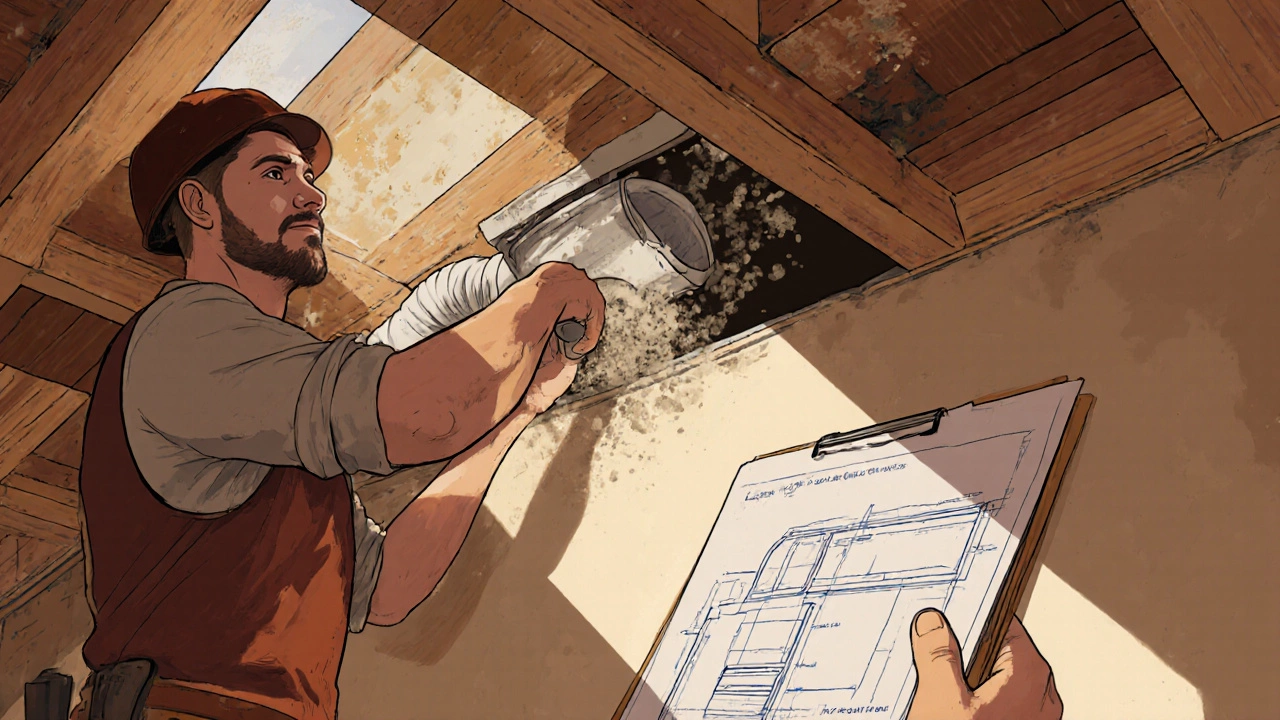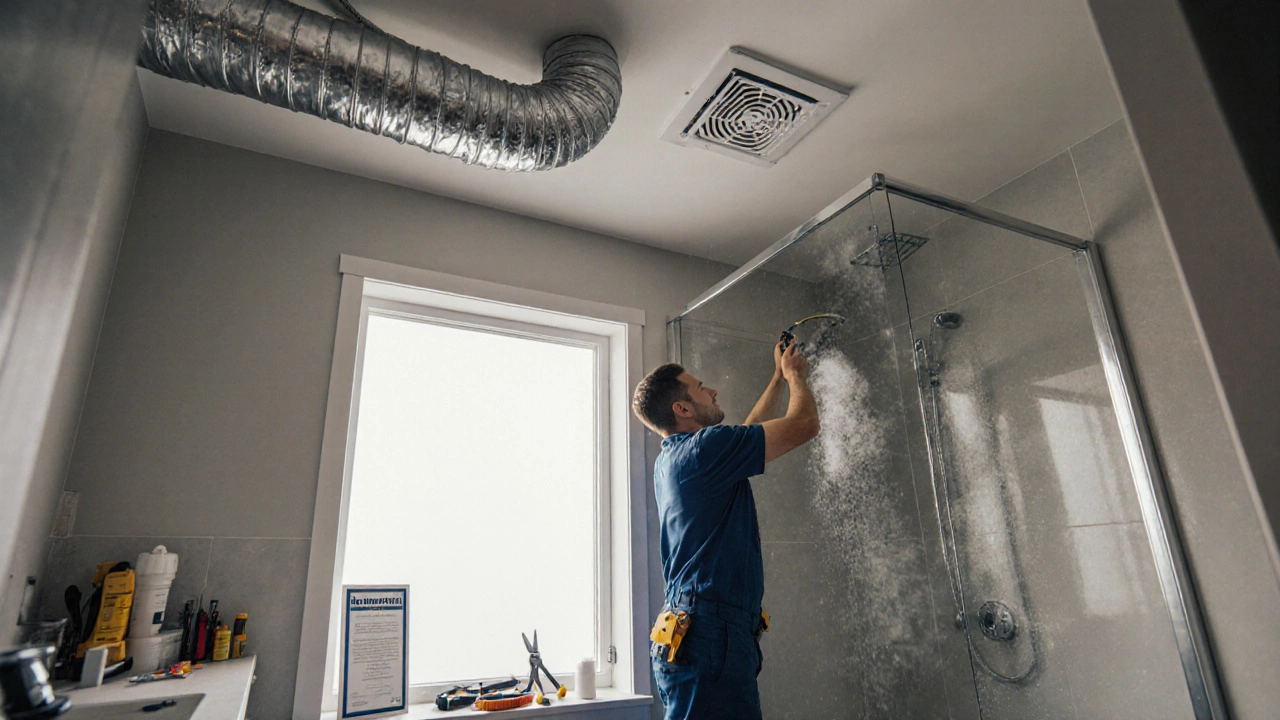Ever walked into a steamy bathroom after a shower and realized the extractor fan isn’t working? Or noticed grease buildup on your kitchen ceiling because the fan never turned on? You don’t need to live with that. But the real question isn’t whether you need a fan - it’s who actually fits one. Not every handyman can do it right. And doing it yourself? That’s where things get risky.
It’s Not Just About Screwing in a Fan
Extractor fans aren’t like hanging a picture. They’re connected to your home’s ventilation system, electrical wiring, and sometimes ductwork that runs through walls, ceilings, or roof spaces. A poorly installed fan doesn’t just fail to remove moisture or odors - it can cause mold, rot, or even fire hazards. In New Zealand homes built before 2010, many extractor fans were retrofitted with no proper ducting, leading to condensation damage in roof cavities. That’s why you need someone who understands airflow, building codes, and electrical safety - not just someone with a drill.Electricians Are the Go-To for Most Installations
If your extractor fan needs to be wired into your home’s electrical system - which most do - you need a licensed electrician. In New Zealand, any permanent electrical fixture that connects to a circuit must be installed by a registered electrician under the Electrical (Safety) Regulations 2010. That includes extractor fans with timers, humidity sensors, or motion detectors. Even if the fan looks simple, if it plugs into a wall socket or connects to a switch, it’s electrical work.Some electricians specialize in residential ventilation. They know how to route ducting without compromising insulation, how to seal penetrations to prevent air leaks, and how to size the fan correctly for the room. A bathroom under 5m² needs a fan rated for at least 15 L/s. A larger bathroom or one with a shower needs 25 L/s or more. An electrician will check that before installing anything.
When You Might Need a Builder or Ventilation Specialist
If you’re installing a new extractor fan where none existed before - especially in a bathroom or kitchen with no existing duct path - you might need a builder or ventilation specialist. This is common in older homes where the roof space isn’t easily accessible, or where you need to cut through brick, concrete, or timber framing.A builder can handle the structural work: cutting holes in walls, installing flue pipes, adding roof vents, or sealing around penetrations. They’ll also make sure the ducting slopes correctly (at least 1:100) so moisture doesn’t pool inside. Poor slope = water buildup = mold growth. I’ve seen too many homes where a fan was installed, but the duct ran flat across the ceiling, collecting condensation like a slow leak.
Some companies offer full ventilation services - they handle both the electrical and ductwork. These are ideal if you’re doing a full bathroom or kitchen renovation. Look for companies that list “extractor fan installation” and “mechanical ventilation” as services, not just “electrical” or “plumbing.”
Plumbers? Usually Not.
Plumbers fix pipes, drains, and water systems. Unless your extractor fan is part of a wet room system that integrates with a condensate drain (which is rare in homes), you won’t need a plumber. Some plumbers offer basic fan installations if they’re tied to a bathroom exhaust system, but they’re not trained in electrical safety standards. If a plumber says they’ll install your fan, ask: “Are you a licensed electrician?” If they say no, walk away.
What About Handyman Services?
Handymen can be great for small jobs - fixing a squeaky door, replacing a tap washer, patching drywall. But when it comes to extractor fans, many handymen lack the qualifications to do electrical work legally. In New Zealand, unlicensed electrical work is illegal and can void your home insurance. If a handyman says they’ll install your fan, make sure they’re working under a licensed electrician’s supervision, or that they’re certified themselves.Ask for their Electrical Workers Registration Board (EWRB) number. You can check it online at ewrb.govt.nz. If they can’t provide it, they’re not qualified. Don’t risk it. A $200 fan isn’t worth a $20,000 mold remediation job later.
Choosing the Right Fan Matters Too
The tradesperson you hire should also help you pick the right fan. Not all fans are created equal. Look for these specs:- CFM or L/s rating - Match it to your room size. A 4m x 5m bathroom needs at least 25 L/s.
- Noise level - Under 1.0 sone is quiet. Anything above 2.0 sone will be annoying.
- IP rating - For bathrooms, you need at least IPX4 (splash-proof). For kitchens, IP44 is ideal.
- Ducting compatibility - Flexible ducting is easier to install but less efficient. Rigid metal ducting lasts longer and moves air better.
- Energy efficiency - Look for fans with DC motors. They use up to 70% less power than AC models.
Brands like Vent-Axia, Xpelair, and Panasonic are widely used in New Zealand homes. Avoid cheap no-name fans from hardware stores - they’re often underpowered, loud, and fail within a year.
What to Expect During Installation
A professional job takes 2-4 hours. Here’s what should happen:- The tradesperson turns off power at the circuit breaker.
- They mark the location - usually above the shower or stove, away from light fixtures.
- They cut the hole and install the fan housing.
- They run ducting to the outside - never into the roof cavity or attic.
- They connect the wiring and test the fan.
- They seal all gaps around the duct and fan with fire-rated sealant.
- They provide a compliance certificate if it’s a new installation.
If they skip the compliance certificate, ask why. In New Zealand, any new electrical installation requires a Certificate of Compliance (CoC). This isn’t optional - it’s law. Without it, you can’t sell your home without disclosing the unapproved work.

Red Flags to Watch For
Watch out for these warning signs:- The person says, “I’ll just plug it into the nearest outlet.” - That’s not permanent installation.
- They use flexible plastic ducting that looks like a vacuum cleaner hose.
- They don’t mention building code compliance or insulation.
- They refuse to show their license or registration.
- The fan is mounted directly above the bath without a proper IP rating.
If you see any of these, walk away. A good tradesperson will explain the process, show you their credentials, and answer your questions without getting defensive.
How Much Should You Pay?
In Dunedin and other parts of New Zealand, a standard extractor fan installation by a licensed electrician costs between $250 and $500. That includes the fan (if you supply it) or a mid-range model (around $150-$250). If ducting needs to be extended through walls or roof, add $100-$200. Don’t be tempted by quotes under $200 - you’re paying for the license, insurance, and expertise, not just labor.What If Your Fan Just Broke?
If your fan is making noise, vibrating, or not pulling air, it might not need a full replacement. Sometimes it’s just a dirty motor, a broken capacitor, or a blocked duct. A qualified technician can clean it, replace the motor, or clear the duct for under $100. But if the housing is cracked or the wiring is frayed - replace it. Don’t try to repair a failing electrical system.Final Tip: Get It Right the First Time
Extractor fans are one of those silent heroes in your home. When they work, you don’t notice them. When they fail, you pay for it - in mold, mildew, and ruined drywall. Don’t cut corners. Hire a licensed electrician for the wiring. Bring in a builder if ducting needs structural changes. And always get that Certificate of Compliance. It’s not red tape - it’s protection.Can I install an extractor fan myself?
Technically, yes - but only if you’re a licensed electrician. In New Zealand, any permanent electrical installation must be done by a registered professional. Even if you’re confident with tools, wiring a fan to your home’s circuit without a license is illegal and voids your insurance. If you’re just replacing an old fan with a new one of the same type, a licensed electrician can still do it quickly and safely.
Do extractor fans need to vent outside?
Yes. Extractor fans must vent directly to the outside, never into the roof space, attic, or wall cavity. Venting into these areas causes moisture buildup, which leads to mold, rot, and structural damage. Building codes in New Zealand require external venting for all extractor fans in bathrooms and kitchens. If your fan is ducted into the roof, it’s not compliant - and it’s a health hazard.
How do I know if my fan is powerful enough?
Multiply the room’s volume in cubic meters by 10 to get the minimum airflow needed in liters per second (L/s). For example, a 4m x 3m x 2.4m bathroom = 28.8m³. 28.8 x 10 = 288 L/h, which equals 0.08 L/s - that’s too low. Actually, the standard is 15-25 L/s for bathrooms, regardless of size. A 5m² bathroom should have at least a 25 L/s fan. Check the fan’s label - it should list the airflow in L/s.
What’s the difference between an extractor fan and a range hood?
An extractor fan removes air from a room - usually a bathroom or toilet - and vents it outside. A range hood is designed specifically for kitchens and captures grease, smoke, and steam from cooking. Range hoods often have filters and higher airflow (50-100 L/s). They’re also mounted above the stove, not on the wall or ceiling. Don’t use a bathroom extractor fan in the kitchen - it won’t handle grease or heat.
How long does an extractor fan last?
A good-quality extractor fan lasts 8-12 years with regular cleaning. Cheap models often fail in 3-5 years. Signs of aging include loud humming, slow spin, or intermittent operation. Clean the blades and motor housing every 6 months. If it’s over 10 years old and starting to act up, replacement is cheaper than repair.
